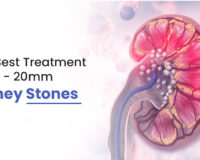If you’ve ever experienced kidney stones, you know how incredibly painful and disruptive they can be. Many people facing this issue often question if and when surgery is needed. It’s a common concern, and understanding the situations that call for surgical intervention is key to managing your health effectively. So, let’s dive into the details of when surgery becomes a necessary step in treating kidney stones.
Kidney Stones & Surgical Necessity
Kidney stones are clusters of crystals that form from minerals and other substances in your urinary tract. While they can sometimes pass on their own, the process can be quite painful as they move through the ureter and urinary tract. In cases where the stone cannot pass naturally or causes a blockage, a procedure to break up or remove the stone may be necessary. Surgery may be necessary and recommended if:-
- Stones are larger than 8-9mm in size or causing severe pain.
- Stones remain stuck in the ureters for an extended period (15-20 days) without passing naturally.
- Stones cause persistent bleeding that does not resolve.
- Presence of infection due to the stone.
- Stone is located in a single kidney.
- The patient is preparing for a kidney transplant.
- Stone is impairing kidney function.
- Stones require surgery if the patient’s occupation involves remote locations (Merchant navy, etc) without accessible medical treatment, even for smaller stones.
Knowing when surgery is the best option helps ensure you get effective treatment and relief from symptoms.
How many Types of Kidney Stones Are there?
Kidney stones can vary in composition, and understanding their types can help in managing and preventing them effectively:
1. Calcium-Oxalate and Calcium Phosphate Stones:
- Composition: These stones are primarily made of calcium combined with oxalate or phosphate.
- Causes: They often form due to factors such as a diet rich in oxalate, low calcium intake, dehydration, or certain medical conditions that increase calcium or oxalate levels in urine. Genetic factors can also play a role.
- Prevalence: Calcium-oxalate stones are the most common type, accounting for about 70-80% of all kidney stones.
- Management: Treatment involves dietary changes to reduce oxalate intake, increased fluid intake to prevent stone formation, and sometimes medications to manage calcium levels in urine. In some cases, procedures may be necessary if conservative measures fail.
2. Uric Acid Stones:
- Composition: These stones form when there is an excess of uric acid in the urine, which can crystallize and form stones.
- Causes: High intake of animal proteins, which increases uric acid production, or conditions like gout that lead to elevated uric acid levels in the body.
- Prevalence: Uric acid stones account for about 5-10% of kidney stones.
- Management: Treatment includes dietary modifications to reduce purine intake, increased fluid intake to dilute urine, and medications to lower uric acid levels. Procedures may be considered if conservative measures are ineffective.
3. Struvite Stones:
- Composition: Struvite stones are composed of magnesium, ammonium, and phosphate.
- Causes: They typically form due to urinary tract infections (UTIs) caused by specific bacteria that produce urease, an enzyme that promotes stone formation.
- Characteristics: Struvite stones can grow quite large and may form a staghorn calculus, which fills a significant portion of the kidney’s collecting system.
- Management: Treatment involves treating the underlying infection with antibiotics and may require surgical removal due to their size and complexity if conservative treatments fail.
4. Cystine Stones:
- Composition: Cystine stones are made of the amino acid cystine.
- Causes: They result from a genetic condition called cystinuria, where defects in renal tubular transport lead to excessive cystine in the urine, causing stones to form.
- Prevalence: Cystine stones are rare, accounting for less than 1% of kidney stones.
- Management: Treatment focuses on dietary adjustments to reduce cystine intake and medications to prevent cystine crystallization. Procedures may be necessary if conservative approaches do not resolve the issue.
Understanding the type of kidney stone you have is essential for tailoring treatment to effectively manage symptoms, prevent recurrence, and promote kidney health.
The Diagnosis Of Kidney Stones
Diagnosing kidney stones involves a comprehensive approach using various tests to assess their presence and characteristics accurately:
- Imaging Tests:
- Types: Ultrasound (sonography), KUB (Kidneys, Ureters, Bladder X-ray), X-rays, and CT scans (computed tomography).
- Purpose: These imaging techniques allow healthcare providers to visualize the size, shape, location, and number of kidney stones.
- Significance: Detailed imaging helps in planning appropriate treatment strategies.
- Urine Test:
- Purpose: Examines urine for blood, crystals indicative of stone formation, and signs of infection.
- Importance: Confirms the presence of kidney stones and identifies any associated urinary tract infections.
- Blood Tests:
- Objective: Assesses kidney function, detects infections, and measures levels of substances like calcium that contribute to stone formation.
- Diagnostic Value: Helps identify conditions predisposing to kidney stones and indicates complications from existing stones.
By utilizing these diagnostic tools, healthcare providers can effectively diagnose kidney stones, determine their characteristics, and develop tailored treatment plans to manage the condition.
What Size Of Kidney Stone Requires Surgery?
Kidney stones come in various sizes, ranging from as small as a grain of sand to as large as a tennis ball. Factors like high salt intake and BMI can affect their growth. The size and shape of a kidney stone significantly influence symptoms and treatment recommendations. Apart from size even the shape of a kidney stone significantly impacts the symptoms experienced and guides treatment recommendations.
Smaller stones, typically under 5 mm, often pass naturally, especially if they have a smooth, capsule-like shape. However, if the shape is uneven, irregular, or rough, medical procedures may be necessary. Further, stones larger than this can be more challenging to pass, potentially causing blockages and discomfort. Seeking medical attention is crucial for larger stones to prevent complications.
When to See a Doctor for Kidney Stone Surgery?
To determine when to seek medical attention for kidney stone treatment, it’s crucial to recognize symptoms and their severity. If you experience any of the following, consider scheduling an appointment with a urologist:
- Severe pain and discomfort
- Flank pain or lower back pain
- Frequent nausea
- Blood in urine
- Difficulty passing urine
- Strong urge to urinate or burning sensation during urination
- Urinary tract infection with fever
Prompt medical evaluation helps in timely intervention to prevent complications associated with kidney stones.
Conclusion
Kidney stones can be very painful, but at CureStone, we specialize in pain-free treatment options like RIRS (Retrograde Intrarenal Surgery), ideal for 5mm to 30mm kidney stones in signe go. This minimally invasive procedure uses a flexible endoscope to remove stones comfortably. Our patients’ testimonials showcase their happiness and relief immediately post-surgery. CureStone focuses on advanced, minimally discomforting treatments for kidney stone removal.





